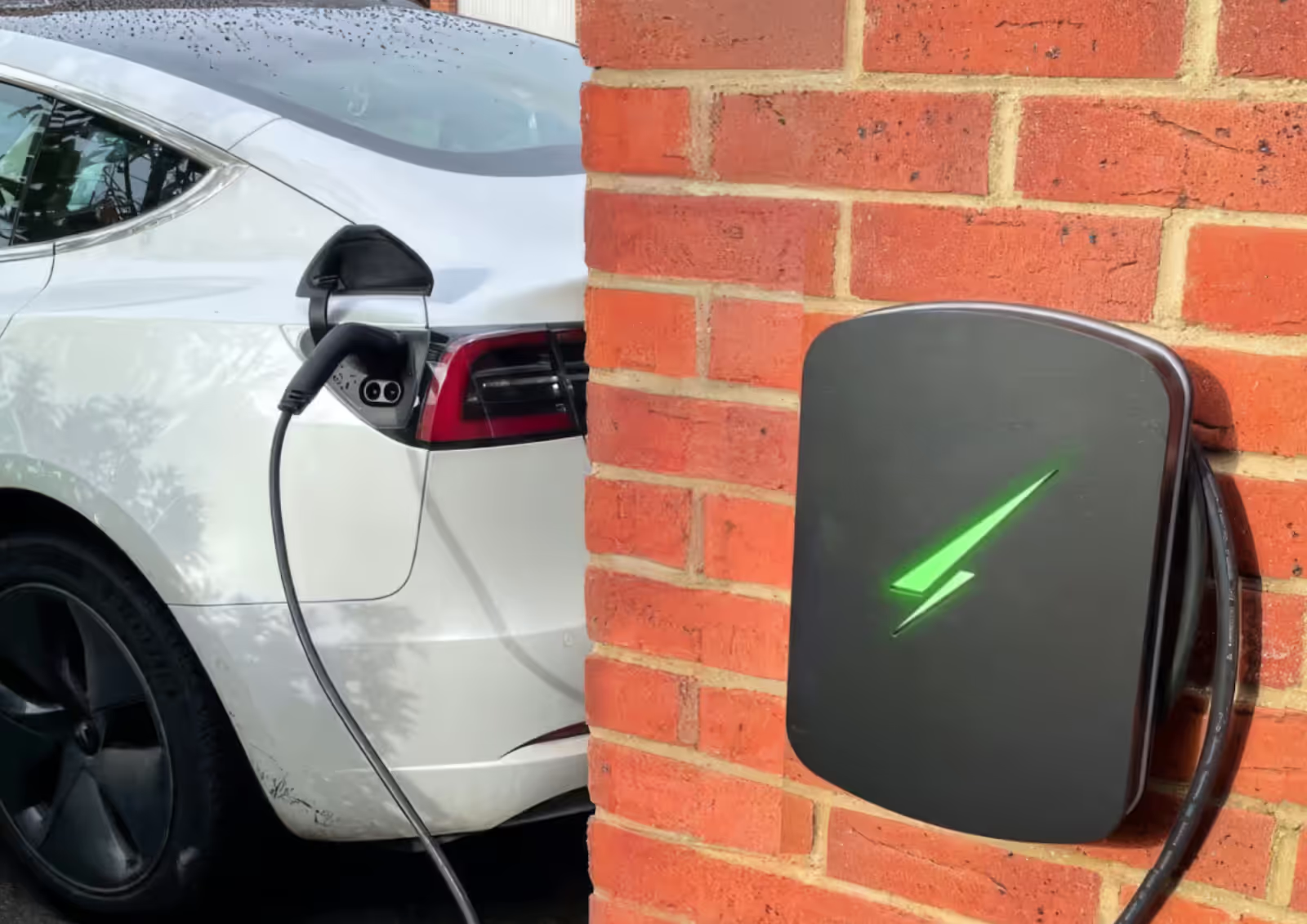How to Install an EV Charger at Home: A Guide to Installation

Buying an EV is simple. Getting one through salary sacrifice is even simpler. Installing a charger at home? That’s a little more involved.
You can’t just order a box online and plug it in yourself. UK law requires a certified installer, and your property setup can make the process different.
This guide breaks down exactly how to install an EV charger at home in the UK, from what to check before booking to what happens on the day, plus the costs and smart tips that help you get the most out of charging at home.
4 things you need to know before installing a home EV charger
Before anything, it’s worth making sure your property ticks a few key boxes.
1. Do you have a suitable location?
A home charger only works if you’ve got off-street parking and a nearby wall to mount it on. In most cases that means a driveway, garage, carport, or a private parking space with decent Wi-Fi coverage. The key is keeping the charger within about 15 metres of your fuse box—longer cable runs add cost and complexity.
Installers will also check a few positioning rules: the charger needs to sit 750–1200mm above ground, at least 2 metres back from public roads or pavements, with a clear route for cable runs and a strong enough Wi-Fi signal to support smart features.
2. Does that location have adequate power supply?
Most UK homes can handle a standard 7kW EV charger, but your fuse box needs to have enough spare capacity and a main fuse rated between 60–100A. The closer your fuse box is to the charger location, the simpler (and cheaper) the job will be—anything beyond 15 metres usually pushes costs up.
Your installer will assess available electrical capacity and whether your single-phase supply can handle 7kW charging perfectly.
Potential electrical upgrades may include: replacing your consumer unit (£300–£600), adding extra circuit protection, or ensuring RCD compliance with BS 7671 regulations. And in every case, the installation must be signed off by your local Distribution Network Operator (DNO).
3. Do you have permission to install an EV charger at home?
Permission requirements vary by property type and location.
If you own your property and have off-street parking, you can usually go ahead without planning permission under current 2025 rules. You’ll still need to meet building regulations, and extra approvals may apply if your home is listed or in a conservation area.
If you’re renting, you’ll need written permission from your landlord before installation.
But don’t worry. Landlords can’t unreasonably refuse, and OZEV grants of up to £350 are available for tenants, which makes it easier to get approval. Landlords often see the benefit too, since a charger can add long-term value to the property.
4. Can you install an EV charger yourself?
No. In the UK, EV chargers must be fitted by a certified professional (NICEIC or NAPIT registered). That’s because installation involves creating a new electrical circuit and connecting safety-critical equipment—something DIY work can’t legally or safely cover.
Trying to do it yourself risks fire, electrocution, voided insurance, and cancelled warranties. A professional installer not only keeps you safe but also ensures compliance with BS 7671 wiring regulations and provides the certification you’ll need for insurance and resale.
Step-by-step: How home EV charger installation works
Knowing what happens at each stage of the installation process helps set expectations and makes the whole experience stress-free. Here’s home EV charger installation works:
Step 1: Pre-installation survey
Before installation day, your installer needs to confirm that your property is suitable for a charger and plan how the work will be carried out. This survey can happen in three ways:
- Video call – you show them your fuse box and parking area using your phone
- Photo submissions – you send over pictures of the areas they need to see
- In-person visit – a full property check if your setup looks more complex
During the survey, they’ll look at your fuse box capacity, where the cabling will run, and whether your Wi-Fi signal is strong enough to support a smart charger.
They’ll also apply for approval from your local electricity network, known as the Distribution Network Operator (DNO).
Why it’s needed: The DNO checks that your local grid can handle the extra demand from your charger without causing supply issues for neighbouring homes.
Who handles it: Your installer takes care of the entire application process on your behalf.
How long it takes: Typically several weeks, though it depends on your region. Your installer will keep you updated on progress.
Step 2: Quote and contract
Once your survey is complete, you’ll receive a detailed quote that breaks down exactly what you’re paying for. A good quote should clearly show:
- Equipment costs: £450–£800 for the charger unit itself
- Labour charges: £300–£600 for installation work
- Extra electrical work: Only added if your fuse box needs upgrading
- Government grants: Up to £350 off if you qualify as a tenant or landlord
When reviewing the contract, check for:
- Warranty coverage: At least a 3-year guarantee on parts and labour
- Certificates included: All legal paperwork, like the Electrical Installation Certificate, should be provided at no extra cost
- Installation timeline: Most jobs are scheduled within 1–4 weeks after signing
- Payment terms: Some installers offer payment plans or finance options if you prefer not to pay in full upfront
What this means for you: No hidden costs, a clear timeline, and peace of mind from proper certification and warranties.
Step 3: Installation day
Most home charger installations take between 2–5 hours. The process is straightforward, and the installer will talk you through each stage.
Before the work begins, they’ll:
- Do a final walkthrough to confirm the exact charger location
- Give a quick safety briefing and explain any temporary disruption
- Plan the power switch-off (usually just 15–30 minutes)
- Double-check they have all the necessary equipment
During the installation, they’ll:
- Mount the charger securely on the agreed wall or structure
- Run armoured, weatherproof cabling back to your fuse box
- Connect it to your electrical system with its own switches and safety devices
- Drill and seal any necessary holes, making sure cables are neatly protected
What this means for you: A professional fit with minimal disruption to your day, and only a brief power cut while the final connections are made.
Our tip: Plan to be at home during installation. That way you can confirm the charger’s position before anything gets drilled, and ask questions while the engineer is on-site.
Step 4: Testing and setup
Before leaving, your installer will run a full series of checks and walk you through how to use your new charger. That way they don’t leave only to get called back again.
Safety testing includes:
- Electrical checks to confirm every connection is secure
- Emergency stop test to ensure cut-off features work properly
- Power flow test to confirm the charger delivers the right output
- Protection device test to check the safety switches that prevent electrical faults
Getting your charger connected and working involves:
- Setting up Wi-Fi so the charger can connect to your home internet
- Downloading and installing the mobile app for remote control
- Running a first charge using your car to confirm everything works
- Walking you through the charger’s lights, buttons, and features
What this means for you: Your charger is tested, connected, and ready to go. You’ll leave installation day knowing it’s safe, fully functional, and that you can confidently operate it from day one.
Step 5: Certification and compliance
Every home EV charger installation in the UK must be legally certified. You’ll receive the following from the person who has installed your home EV charger:
- Electrical Installation Certificate (EIC) within 30 days
- Building regulations compliance confirmation
- DNO notification completion
- Warranty registration with manufacturer
It’s essential to make sure your installer is Competent Person–registered (through bodies like NICEIC or NAPIT). Only registered professionals can legally certify their own work, which means you skip the hassle of council inspections and your charger is compliant from the moment it’s installed. Without this, you risk invalidating your home insurance and missing the paperwork you’ll need for future property sales or claims. A registered installer gives you legal protection, proper certification, and long-term peace of mind.
Our tip: Keep all certificates and warranty details in a safe place—you’ll need them for insurance, resale, or if you ever switch energy providers.
How long does home EV charger installations take?
For most households, installation of an EV charger can be done in under half a day. But complicated setups may see that timeline stretch to one full day or more.
Simple jobs, where the charger is positioned close to the fuse box, are usually wrapped up in just a few hours. If extra cabling or small electrical tweaks are required, the work may take a little longer but still comfortably fits into a single visit.
It’s only when major upgrades come into play, like replacing the fuse box, running cable underground, or converting to a three-phase supply, that installation can spill over into a full day or, in rare cases, multiple visits.
How much does it cost to install an EV charger at home?
Most UK households spend between £800 and £1,500 on a complete home EV charger installation, with the average sitting at around £1,110. That figure covers both the charger unit (£450–£800) and professional labour (£300–£600).

The final price depends on three main factors:
- Charger type – Smart chargers usually cost £100–£300 more than basic models, but the ability to schedule charging for off-peak hours can save you far more in running costs.
- Property setup – Short, simple cable runs keep costs low, while longer distances or tricky installation spots add to labour time and materials.
- Electrical upgrades – If your fuse box or wiring isn’t up to modern standards, upgrades can add £300–£600 for a consumer unit replacement or £150–£300 for an earth rod.
Location also matters. Installations in London and the Southeast often cost 10–15% more than the UK average, while prices in Northern regions tend to be 5–10% lower.
Want the full picture, including how to keep costs down? Check out our complete guide on EV charger installation costs in the UK.
What to do after installation
Once your charger is installed, a few follow-up steps will help you protect your investment and cut ongoing costs.
Register your charger and warranty
Complete the manufacturer’s warranty registration within 30 days and store your installation certificates safely.
Keeping proof of purchase is also important for insurance purposes, since most warranties only remain valid with professional installation. Manufacturers typically offer between three and five years of cover.
Download and set up your companion app
Connect your charger to your home Wi-Fi and install the mobile app. From here, you can schedule charging for off-peak hours, track energy use, and make adjustments to get the most from your setup.
Pair with a charge card for backup
It’s worth having a charge card ready for when you’re travelling. The best options provide access to thousands of public charge points across the UK and Europe at competitive rates, giving you peace of mind if home charging isn’t available.
Monitor usage and switch to an EV tariff
Track your usage through the app and consider moving to a specialist EV tariff. With off-peak rates as low as 7–9p per kWh, you can cut charging costs by up to 75%.
Make sure your smart meter is set up for half-hourly readings so your supplier can link your charger to cheaper overnight rates.
Save up to 60% on charging with the loveelectric Charge
Even with a home charger, you'll still need public charging for longer journeys which can end up being pricey. The loveelectric Charge Card is a must-have solution that offers up to 60% discounts on both home and public charging, ensuring you keep charging costs low even when plugging in on the go or if a home charger isn't on the cards right now.
How the Charge Card works: As an employee you sacrifice the right amount from your salary, based on mileage and charging habits. You can then use your virtual Visa card at any UK charger or with home energy suppliers.
The best bit? You don’t need to be an existing loveelectric client. The Charge Card bolts onto any existing EV salary sacrifice scheme or company car (as long as it’s electric of course).
Ready to save on charging your EV at home and in public? Learn more about the loveelectric Charge Card or watch our 3-minute explainer.





.webp)